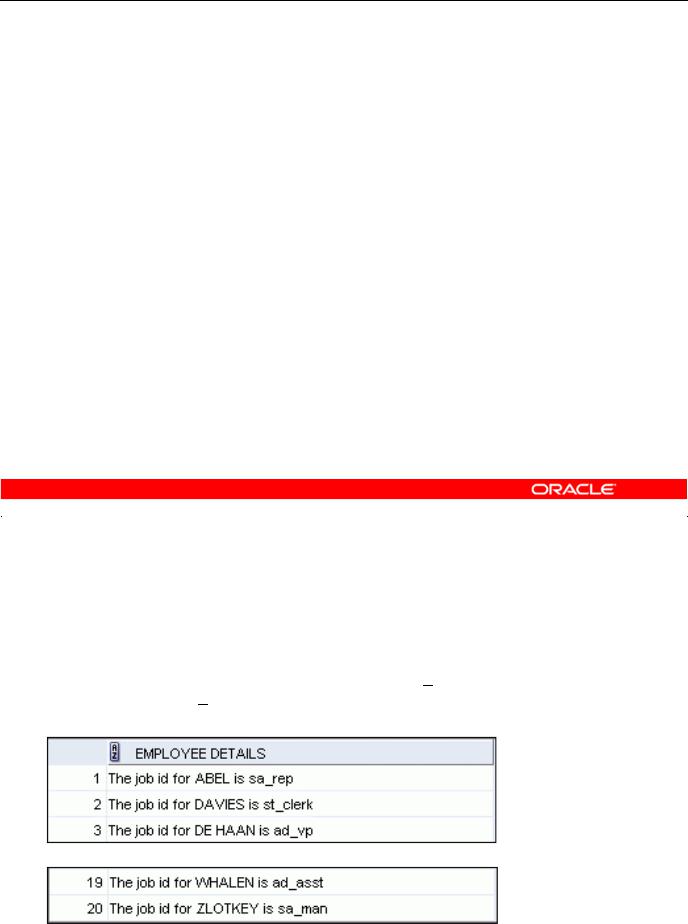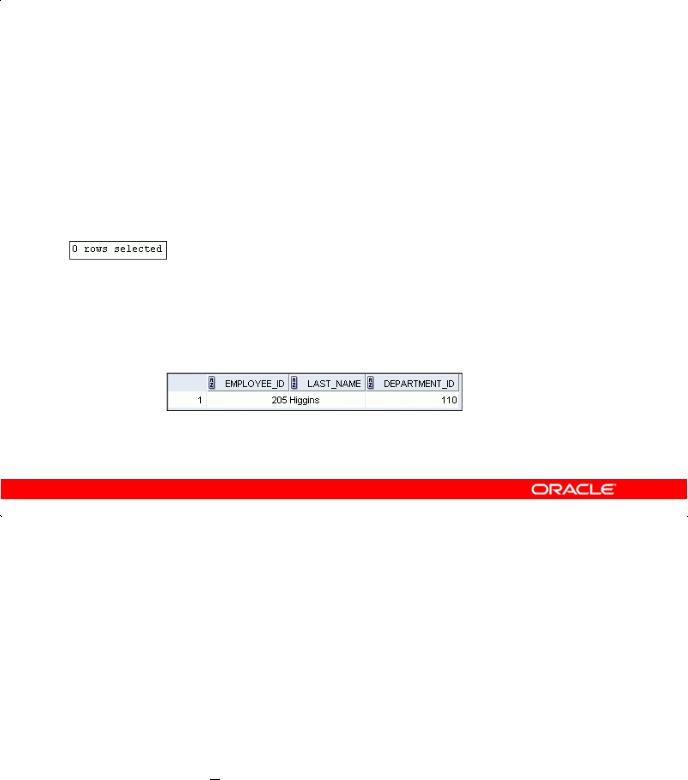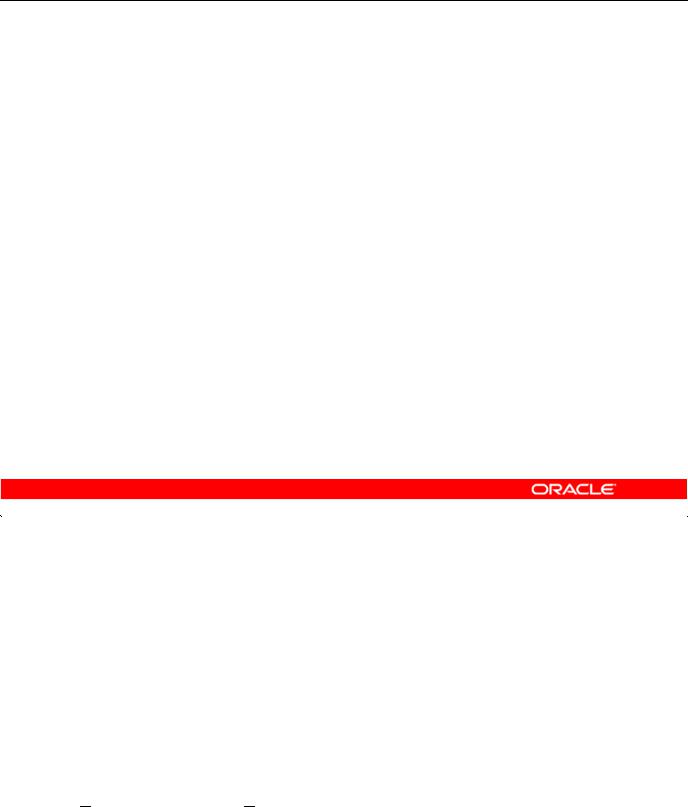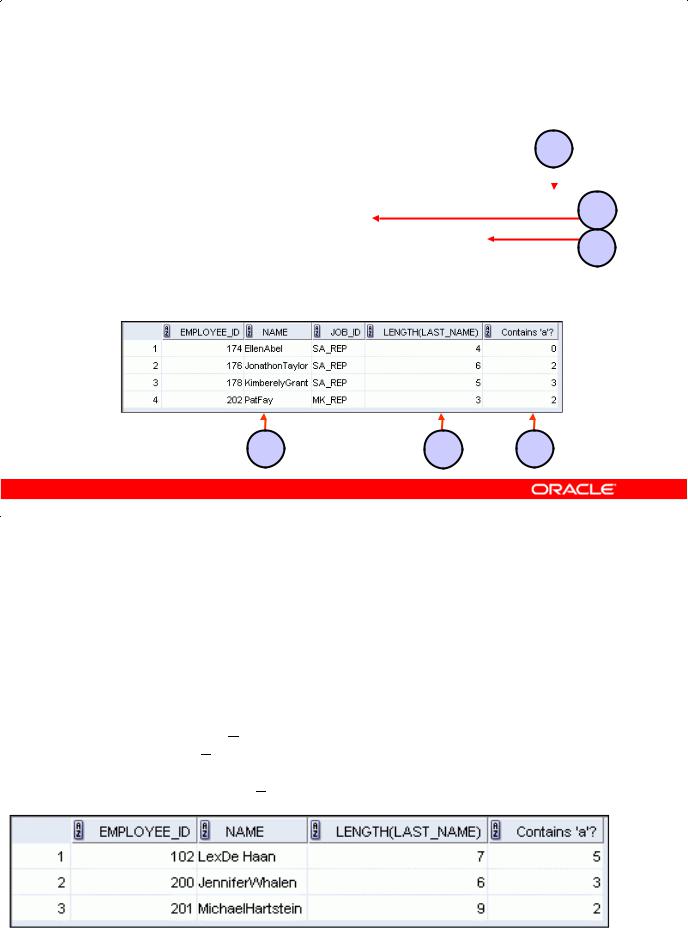
- •Preface
- •Introduction
- •Lesson Objectives
- •Lesson Agenda
- •Course Objectives
- •Course Agenda
- •Appendixes Used in the Course
- •Lesson Agenda
- •Oracle Database 11g: Focus Areas
- •Oracle Database 11g
- •Oracle Fusion Middleware
- •Oracle Enterprise Manager Grid Control 10g
- •Oracle BI Publisher
- •Lesson Agenda
- •Relational and Object Relational Database Management Systems
- •Data Storage on Different Media
- •Relational Database Concept
- •Definition of a Relational Database
- •Data Models
- •Entity Relationship Model
- •Relating Multiple Tables
- •Relational Database Terminology
- •Lesson Agenda
- •Using SQL to Query Your Database
- •SQL Statements
- •Development Environments for SQL
- •Lesson Agenda
- •The Human Resources (HR) Schema
- •Tables Used in the Course
- •Lesson Agenda
- •Oracle Database 11g Documentation
- •Additional Resources
- •Summary
- •Practice I: Overview
- •Objectives
- •Lesson Agenda
- •Capabilities of SQL SELECT Statements
- •Basic SELECT Statement
- •Selecting All Columns
- •Selecting Specific Columns
- •Writing SQL Statements
- •Column Heading Defaults
- •Lesson Agenda
- •Arithmetic Expressions
- •Using Arithmetic Operators
- •Operator Precedence
- •Defining a Null Value
- •Null Values in Arithmetic Expressions
- •Lesson Agenda
- •Defining a Column Alias
- •Using Column Aliases
- •Lesson Agenda
- •Concatenation Operator
- •Literal Character Strings
- •Using Literal Character Strings
- •Alternative Quote (q) Operator
- •Duplicate Rows
- •Lesson Agenda
- •Displaying the Table Structure
- •Using the DESCRIBE Command
- •Quiz
- •Summary
- •Practice 1: Overview
- •Objectives
- •Lesson Agenda
- •Limiting Rows Using a Selection
- •Limiting the Rows That Are Selected
- •Using the WHERE Clause
- •Character Strings and Dates
- •Comparison Operators
- •Using Comparison Operators
- •Range Conditions Using the BETWEEN Operator
- •Membership Condition Using the IN Operator
- •Pattern Matching Using the LIKE Operator
- •Combining Wildcard Characters
- •Using the NULL Conditions
- •Defining Conditions Using the Logical Operators
- •Using the AND Operator
- •Using the OR Operator
- •Using the NOT Operator
- •Lesson Agenda
- •Rules of Precedence
- •Lesson Agenda
- •Using the ORDER BY Clause
- •Sorting
- •Lesson Agenda
- •Substitution Variables
- •Using the Single-Ampersand Substitution Variable
- •Character and Date Values with Substitution Variables
- •Specifying Column Names, Expressions, and Text
- •Using the Double-Ampersand Substitution Variable
- •Lesson Agenda
- •Using the DEFINE Command
- •Using the VERIFY Command
- •Quiz
- •Summary
- •Practice 2: Overview
- •Objectives
- •Lesson Agenda
- •SQL Functions
- •Two Types of SQL Functions
- •Single-Row Functions
- •Lesson Agenda
- •Character Functions
- •Case-Conversion Functions
- •Using Case-Conversion Functions
- •Character-Manipulation Functions
- •Using the Character-Manipulation Functions
- •Lesson Agenda
- •Number Functions
- •Using the ROUND Function
- •Using the TRUNC Function
- •Using the MOD Function
- •Lesson Agenda
- •Working with Dates
- •RR Date Format
- •Using the SYSDATE Function
- •Arithmetic with Dates
- •Using Arithmetic Operators with Dates
- •Lesson Agenda
- •Date-Manipulation Functions
- •Using Date Functions
- •Using ROUND and TRUNC Functions with Dates
- •Quiz
- •Summary
- •Practice 3: Overview
- •Objectives
- •Lesson Agenda
- •Conversion Functions
- •Implicit Data Type Conversion
- •Explicit Data Type Conversion
- •Lesson Agenda
- •Using the TO_CHAR Function with Dates
- •Elements of the Date Format Model
- •Using the TO_CHAR Function with Dates
- •Using the TO_CHAR Function with Numbers
- •Using the TO_NUMBER and TO_DATE Functions
- •Using the TO_CHAR and TO_DATE Function with RR Date Format
- •Lesson Agenda
- •Nesting Functions
- •Lesson Agenda
- •General Functions
- •NVL Function
- •Using the NVL Function
- •Using the NVL2 Function
- •Using the NULLIF Function
- •Using the COALESCE Function
- •Lesson Agenda
- •Conditional Expressions
- •CASE Expression
- •Using the CASE Expression
- •DECODE Function
- •Using the DECODE Function
- •Quiz
- •Summary
- •Practice 4: Overview
- •Objectives
- •Lesson Agenda
- •What Are Group Functions?
- •Types of Group Functions
- •Group Functions: Syntax
- •Using the AVG and SUM Functions
- •Using the MIN and MAX Functions
- •Using the COUNT Function
- •Using the DISTINCT Keyword
- •Group Functions and Null Values
- •Lesson Agenda
- •Creating Groups of Data
- •Creating Groups of Data: GROUP BY Clause Syntax
- •Using the GROUP BY Clause
- •Grouping by More than One Column
- •Using the GROUP BY Clause on Multiple Columns
- •Illegal Queries Using Group Functions
- •Restricting Group Results
- •Restricting Group Results with the HAVING Clause
- •Using the HAVING Clause
- •Lesson Agenda
- •Nesting Group Functions
- •Quiz
- •Summary
- •Practice 5: Overview
- •Objectives
- •Lesson Agenda
- •Types of Joins
- •Joining Tables Using SQL:1999 Syntax
- •Qualifying Ambiguous Column Names
- •Lesson Agenda
- •Creating Natural Joins
- •Retrieving Records with Natural Joins
- •Creating Joins with the USING Clause
- •Joining Column Names
- •Retrieving Records with the USING Clause
- •Using Table Aliases with the USING Clause
- •Creating Joins with the ON Clause
- •Retrieving Records with the ON Clause
- •Creating Three-Way Joins with the ON Clause
- •Applying Additional Conditions to a Join
- •Lesson Agenda
- •Joining a Table to Itself
- •Self-Joins Using the ON Clause
- •Lesson Agenda
- •Nonequijoins
- •Retrieving Records with Nonequijoins
- •Lesson Agenda
- •INNER Versus OUTER Joins
- •LEFT OUTER JOIN
- •RIGHT OUTER JOIN
- •FULL OUTER JOIN
- •Lesson Agenda
- •Cartesian Products
- •Generating a Cartesian Product
- •Creating Cross Joins
- •Quiz
- •Summary
- •Practice 6: Overview
- •Objectives
- •Lesson Agenda
- •Using a Subquery to Solve a Problem
- •Subquery Syntax
- •Using a Subquery
- •Guidelines for Using Subqueries
- •Types of Subqueries
- •Lesson Agenda
- •Single-Row Subqueries
- •Executing Single-Row Subqueries
- •Using Group Functions in a Subquery
- •The HAVING Clause with Subqueries
- •What Is Wrong with This Statement?
- •No Rows Returned by the Inner Query
- •Lesson Agenda
- •Multiple-Row Subqueries
- •Lesson Agenda
- •Null Values in a Subquery
- •Quiz
- •Summary
- •Practice 7: Overview
- •Objectives
- •Lesson Agenda
- •Set Operators
- •Set Operator Guidelines
- •The Oracle Server and Set Operators
- •Lesson Agenda
- •Tables Used in This Lesson
- •Lesson Agenda
- •UNION Operator
- •Using the UNION Operator
- •UNION ALL Operator
- •Using the UNION ALL Operator
- •Lesson Agenda
- •INTERSECT Operator
- •Using the INTERSECT Operator
- •Lesson Agenda
- •MINUS Operator
- •Using the MINUS Operator
- •Lesson Agenda
- •Matching the SELECT Statements
- •Matching the SELECT Statement: Example
- •Lesson Agenda
- •Using the ORDER BY Clause in Set Operations
- •Quiz
- •Summary
- •Practice 8: Overview

Case-Conversion Functions
These functions convert the case for character strings:
Function |
Result |
|
|
LOWER('SQL Course') |
sql course |
|
|
UPPER('SQL Course') |
SQL COURSE |
|
|
INITCAP('SQL Course') |
Sql Course |
|
|
Case-Conversion Functions |
Copyright © 2009, Oracle. All rights reserved. |
Academy |
|
|
|
|
|
|
lowercase |
Oracle |
|
LOWER, UPPER, and INITCAP are the three case-conversion functions.
• LOWER: Converts mixed-case or uppercase character strings to lowercase
• UPPER: Converts mixed-case or lowercase character strings to uppercase
• INITCAP: Converts the first letter of each word to uppercase and the remaining letters to |
||
|
& |
Only |
SELECT 'The job id for '||UPPER(last name)||' is ' |
||
Internal |
|
|
||LOWER(job id) AS "EMPLOYEE DETAILS" |
||
FROM employees; |
Use |
|
|
||
Oracle |
|
|
Oracle Database 11g: SQL Fundamentals I 3 - 11

Using Case-Conversion Functions
Display the employee number, name, and department number for employee Higgins:
SELECT |
employee_id, last_name, department_id |
FROM |
employees |
WHERE |
last_name = 'higgins'; |
|
|
SELECT |
employee_id, last_name, department_id |
|
FROM |
employees |
|
WHERE |
LOWER(last_name) = 'higgins'; |
|
|
|
|
Copyright © 2009, Oracle. All rights reserved. |
Academy |
|
Using Case-Conversion Functions |
|
|
The slide example displays the employee number, name, and department number of employee |
||
Higgins. |
Oracle |
|
|
||
The WHERE clause of the first SQL statement specifies the employee name as higgins. Because all
the data in the EMPLOYEES table is stored in proper case, the name higgins does not find a match
The WHERE clause of the second SQL statement&specifies that the employee name in the |
|
The name in the outputInternalappears as it was stored in the database. To display the name in uppercase, |
|
EMPLOYEES table is compared to higgins, convertingOnlythe LAST_NAME column to lowercase for |
|
comparison purposes. Because both ames are now lowercase, a match is found and one row is |
|
selected. The WHERE clause can be rewritten in the following manner to produce the same result: |
|
...WHERE last name =Use'Higgins' |
|
Oracle |
|
use the UPPER function in the SELECT statement. |
|
SELECT |
employee_id, UPPER(last_name), department_id |
FROM |
employees |
WHERE |
INITCAP(last_name) = 'Higgins'; |
Oracle Database 11g: SQL Fundamentals I 3 - 12

Character-Manipulation Functions
These functions manipulate character strings:
|
Function |
|
Result |
|
|
|
|
|
|
|
|
|
CONCAT('Hello', 'World') |
|
HelloWorld |
|
|
|
|
|
|
|
|
|
SUBSTR('HelloWorld',1,5) |
|
Hello |
|
|
|
|
|
|
|
|
|
LENGTH('HelloWorld') |
|
10 |
|
|
|
|
|
|
|
|
|
INSTR('HelloWorld', 'W') |
|
6 |
|
|
|
|
|
|
|
|
|
LPAD(salary,10,'*') |
|
*****24000 |
|
|
|
|
|
|
|
|
|
RPAD(salary, 10, '*') |
|
24000***** |
|
|
|
|
|
|
|
|
|
REPLACE |
|
BLACK and BLUE |
|
|
|
('JACK and JUE','J','BL') |
|
|
|
|
|
|
|
|
|
|
|
TRIM('H' FROM 'HelloWorld') |
|
elloWorld |
|
|
|
|
|
|
|
|
|
Copyright © 2009, Oracle. All rights reserved. |
Academy |
|||
Character-Manipulation Functions |
|
|
|||
CONCAT, SUBSTR, LENGTH, INSTR, LPAD, |
RPAD, and TRIM are the character-manipulation |
||||
functions that are covered in this lesson.
• LENGTH: Shows the length of a string as a numericOraclevalue
• CONCAT: Joins values together (You are limited to using two parameters with CONCAT.) |
||
• SUBSTR: Extracts a string of determined length |
||
|
& |
Only |
• INSTR: Finds the numeric position of a named character |
||
|
Internal |
|
• LPAD: Returns an expression left-p dded to the length of n characters with a character |
||
expression |
Use |
|
• RPAD: Returns an expression right-padded to the length of n characters with a character
expression
• TRIM: Trims leadi g or trailing characters (or both) from a character string (If
trim character or trim source is a character literal, you must enclose it within single Oraclequotation marks.)
Note: You an use functions such as UPPER and LOWER with ampersand substitution. For example, use UPPER('&job_title')so that the user does not have to enter the job title in a specific case.
Oracle Database 11g: SQL Fundamentals I 3 - 13

Using the Character-Manipulation Functions
|
1 |
|
|
|||||||||
|
|
|
|
|
|
|
|
|
|
|
|
|
SELECT |
employee_id, |
|
|
|
|
|
|
|
|
|
||
CONCAT(first_name, last_name) NAME, |
|
2 |
||||||||||
|
job_id, |
LENGTH (last_name), |
|
|
|
|
|
|||||
|
|
|
|
|
|
|
||||||
|
INSTR(last_name, 'a') "Contains 'a'?" |
|
|
|
3 |
|||||||
FROM |
employees |
|
|
|
||||||||
WHERE |
SUBSTR(job_id, 4) = 'REP'; |
|
||||||||||
|
|
|
|
|
|
|
|
|
|
|
|
|
|
|
|
|
|
|
|
|
|
|
|
|
|
1 |
2 |
3 |
Copyright © 2009, Oracle. All rights reserved. |
Academy |
|
Using the Character-Manipulation Functions |
|
|
Oracle |
||
The slide example displays employee first names and last names join d together, the length of the employee last name, and the numeric position of the letter “a” in the employee last name for all employees who have the string, REP, contained in the job ID starting at the fourth position of the
job ID.
Example: |
|
|
& |
|
|
|
|
|
|
Modify the SQL statement in the slide to display the data for those employees whose last names end |
||||
with the letter “n.” |
Internal |
Only |
||
SELECT |
|
Use |
||
employee id, CONCAT(first_name, last_name) NAME, |
||||
LENGTH |
(last name), INSTR(last_name, 'a') "Contains 'a'?" |
|||
FROM |
|
employ es |
|
|
WHERE |
SUBSTR(last name, -1, 1) = 'n'; |
|||
Oracle |
|
|
|
|
Oracle Database 11g: SQL Fundamentals I 3 - 14
